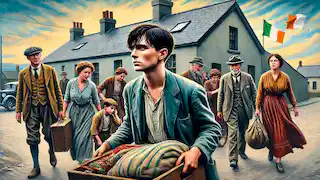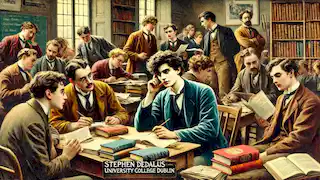Stephen Dedalus, a name synonymous with artistic struggle and intellectual pursuit, hails from the heart of Ireland, a land where myth and modernity intertwine. His journey, a poignant odyssey through the landscapes of Dublin and the recesses of his mind, mirrors the tumultuous quest for identity and expression. This narrative, though fictional, resonates with the timeless human struggle to carve out a unique path amidst societal expectations and personal turmoil. Stephen Dedalus grew up in Blackrock, a quiet suburb of Dublin. The town's serene ambiance, with its lush green fields and gentle sea breeze, was the backdrop of Stephen's early life. Raised in a devout Catholic family, his parents, Simon and Mary Dedalus, instilled in him the values of faith and discipline. Stephen's father, once a spirited man, had now succumbed to the weight of financial burdens, casting a shadow over the Dedalus household. Stephen's academic journey began at Clongowes Wood College, a prestigious Jesuit school. Here, he encountered the rigid structures of religion and education. The school's imposing architecture, with its gothic towers and sprawling grounds, seemed to echo the authority of the priests who ran it. Despite the oppressive atmosphere, Stephen found solace in literature, immersing himself in the works of Aristotle, Aquinas, and Dante. One chilly evening, Stephen wandered into the school's library, seeking refuge from the cacophony of the dormitories. He discovered a dusty old book on aesthetics, which ignited a spark within him. The idea that art could transcend the mundane and elevate the soul resonated deeply. This revelation marked the beginning of his internal rebellion against the conformist environment of Clongowes. As Stephen matured, the Dedalus family's financial situation worsened. His father, once a prosperous man, faced mounting debts and declining social status. The Dedalus family had to move frequently, each new residence more modest than the last. This instability deeply affected Stephen, who saw his father's failures as a symbol of his own fears and uncertainties. Despite their hardships, Simon Dedalus remained optimistic about his son's future, often recounting tales of his own youthful exploits and academic achievements. He placed immense pressure on Stephen to excel academically and restore the family's lost honor. This burden weighed heavily on Stephen, who struggled to balance his father's expectations with his burgeoning artistic aspirations. Amidst the chaos of his home life, Stephen's passion for art grew stronger. He began to distance himself from his peers and the conventional path laid out for him. His school notebooks became canvases for his sketches and verses, each page a testament to his inner turmoil and creative longing. The more he delved into his art, the more he felt alienated from the world around him. One rainy afternoon, while wandering through the streets of Dublin, Stephen stumbled upon an art gallery. He stood mesmerized before a painting of a young woman, her eyes filled with melancholy and grace. The artwork spoke to him in ways words never could, reaffirming his belief in the power of art to capture the essence of the human experience. This encounter solidified his resolve to pursue a life dedicated to artistic creation. Stephen's academic journey continued at University College Dublin, where he was exposed to a broader spectrum of ideas and intellectual currents. The vibrant academic environment, with its heated debates and diverse perspectives, fueled his quest for self-discovery. At university, Stephen formed lasting friendships with like-minded individuals who shared his passion for literature and philosophy. Among them was Cranly, a charismatic and free-spirited student who challenged Stephen's conventional beliefs and encouraged him to question authority. Another significant figure was Professor MacHugh, whose lectures on aesthetics and ethics profoundly influenced Stephen's thinking. Stephen's intellectual awakening brought him into conflict with the conservative values of his upbringing. He often found himself at odds with his professors and peers, who viewed his radical ideas with suspicion. This tension reached its peak during a heated debate on the role of the artist in society. Stephen argued passionately for the autonomy of the artist, insisting that true art must remain free from the constraints of politics and religion. During his university years, Stephen experienced the highs and lows of romantic relationships. His first love, Emma, was a fellow student who shared his intellectual interests but struggled to understand his relentless pursuit of artistic perfection. Stephen and Emma's relationship blossomed through their shared love of poetry and long philosophical discussions. They would often meet at a quaint café near the university, where they would spend hours debating the meaning of life and art. Emma's gentle demeanor and unwavering support provided Stephen with a sense of stability and comfort amidst the chaos of his creative pursuits. Despite their deep connection, Stephen's obsessive dedication to his art eventually drove a wedge between them. He became increasingly consumed by his work, often neglecting Emma and their relationship. The strain became unbearable, and they eventually parted ways, leaving Stephen with a profound sense of loss and regret. Stephen's journey was not just about artistic expression but also about finding his true self. He struggled with the expectations placed upon him by his family, society, and his own inner demons. His quest for identity took him to the brink of despair and back, shaping him into the artist he was destined to become. One fateful evening, while walking along the shores of the Irish Sea, Stephen experienced a moment of profound clarity. The rhythmic sound of the waves crashing against the rocks, the salty breeze, and the endless horizon merged into a symphony of sensations that overwhelmed his senses. In that instant, he realized that his true calling was not to conform to societal expectations but to embrace his unique vision and voice. Armed with this newfound understanding, Stephen resolved to leave Dublin and pursue his artistic dreams. He bid farewell to his family and friends, knowing that his journey would be fraught with challenges and uncertainties. Yet, he felt a sense of liberation and excitement, ready to face whatever lay ahead. Stephen Dedalus's journey is a testament to the transformative power of art and the relentless pursuit of one's true self. His story, deeply rooted in the cultural and historical context of Ireland, continues to inspire and resonate with readers around the world. Through his trials and triumphs, Stephen reminds us of the importance of staying true to our passions and beliefs, no matter the cost.Early Years in Blackrock
The Mysteries of Clongowes Wood College
A Moment of Revelation

Family Struggles and Financial Decline
The Burden of Expectations
The Call of Art
A Chance Encounter

University Life and Intellectual Awakening
The Influence of Friends and Mentors
The Clash of Ideals
Love and Loss
A Heartfelt Connection

The Pain of Separation
The Search for Identity

The Epiphany
A New Beginning
Conclusion
A Portrait of the Artist as a Young Man
Reading Time: 6 min

About Story: A Portrait of the Artist as a Young Man is a Folktale Stories from ireland set in the 20th Century Stories. This Dramatic Stories tale explores themes of Coming of Age Stories and is suitable for Young Stories. It offers Cultural Stories insights. A young artist's journey of self-discovery and artistic awakening in early 20th century Ireland.

















